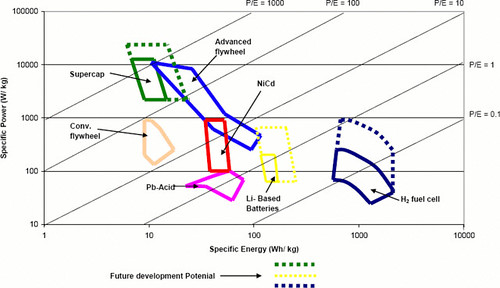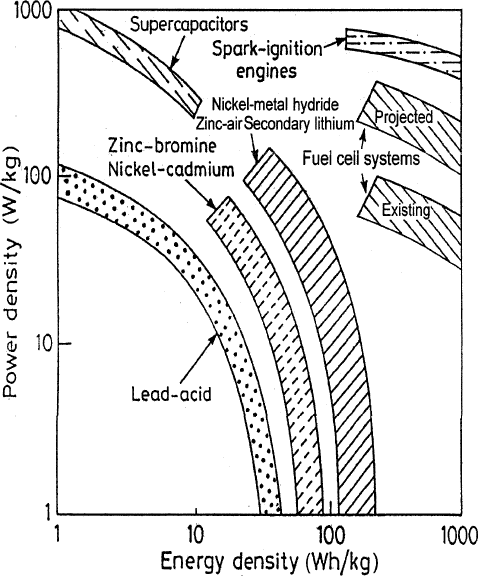Nanotube Supercapacitors--Energy Density vs. Power Density
 Stories like this and this are plentiful today around the web. It is exciting to see features of nanotechnology incorporated into energy technology, to aid the transition away from a petroleum economy. The new carbon nanotube-supercapacitors will be a huge leap above what is currently available.
Stories like this and this are plentiful today around the web. It is exciting to see features of nanotechnology incorporated into energy technology, to aid the transition away from a petroleum economy. The new carbon nanotube-supercapacitors will be a huge leap above what is currently available.
If you look at the graphic above, and the graph to the left, you will notice various energy sources plotted with horizontal axis energy density by vertical axis power density. The power density is how much power the device can supply, and the energy density represents how long the device can supply the power. If you will notice, a supercapacitor is high in the top left corner, representing a high power density, but a low energy density. A supercapacitor can supply a lot of power for a short time.
The fuel cells and battery systems have lower power density, but higher energy density. They can supply lower power but for a longer time. A fuel cell car, for example, might go a long distance if supplied with enough fuel, but it would have difficulty accelerating quickly.
We tend to compare energy delivery systems against the internal combustion engine (ICE), which occupies the upper right hand corner--signifying both high energy density and high power density. An ICE powered automobile can go a long distance, AND accelerate quickly. Any practical substitute for the ICE powered auto would need to do the same.
How can you replace the internal combustion engine's superlative qualities? Obviously, there is no single replacement technology that will do the job. The ultracapacitor gives out too quickly, and the fuel cells lack power boost. But there is a possibility that the combination of nano-supercapacitors with advanced fuel cells, or advanced storage batteries, would come close enough to the performance of an ICE. Using cleaner fuels to generate the capacitor/battery charge, and to provide the fuel for the fuel cell, will help the environment tremendously in comparison with the pollution from an ICE.
If you want more graphs to illustrate the contrasting concepts of energy density and power density, go here. This article has more ideas on using nanotech to improve energy storage. This is a general discussion of ultracapacitors (supercapacitors).
See related Al Fin posts here, and here.
Labels: ultracapacitors

2 Comments:
This strikes a chord with some thinking I've had for a while now. How big is energy? In other words, why can't we store electrical energy at the same densities that are present in gasoline? Or nuclear fuel for that matter. Obviously both of these materials point out that power doesn't really take up much space, otherwise their mass to power output ratio would be smaller. It would seem that the last 100 years or so of quantum mechanics, chemistry and engineering development should give us a hint how to store energy better. That is the case with these stories. In another high-tech story recently some physicists developed a model to describe and predict the hardness of materials. Someone (smarter than me) needs to do the same thing with energy storage materials and geometries.
The nanotube capacitors can take better advantage of the third space dimension. Other nano-materials yet undiscovered might do even better. You can see how although it has been a long time since buckeyballs and nanotubes were discovered, their potential is still just being mind. (a pun, I actually meant mined. From your comment I thought you might appreciate it)
It takes time for us slow-minded chimps to get from there to here to there.
Post a Comment
“During times of universal deceit, telling the truth becomes a revolutionary act” _George Orwell
<< Home